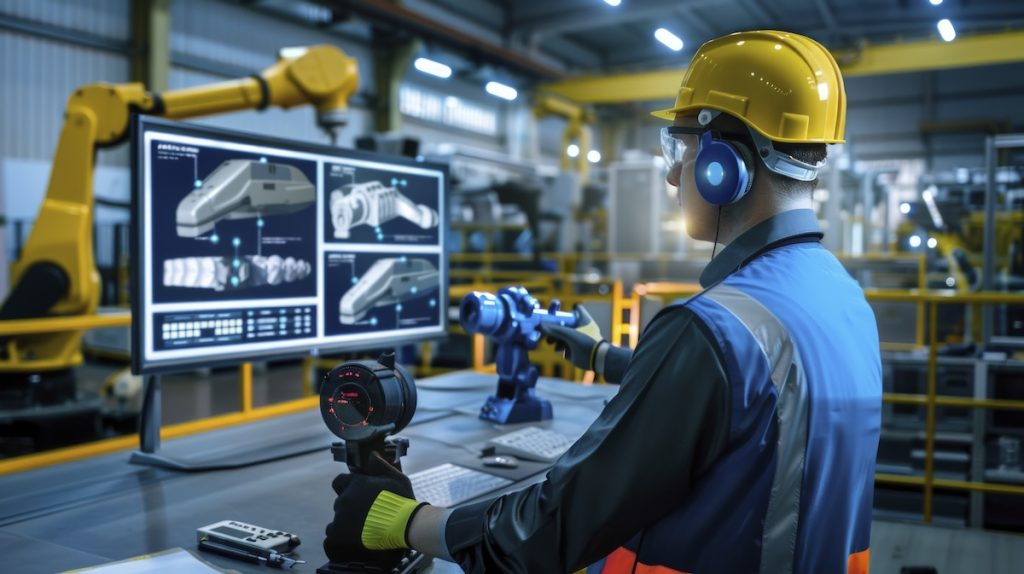The Tipping Point of Smart Manufacturing: Where AI & Digital Twin Usage is Taking Off
While many manufacturers are still on paper processes, manufacturing technology is rapidly evolving, opening up new opportunities for process improvement and innovation.
Smart manufacturing technologies are no longer just a reality for large-scale OEMs or large manufacturers. We are now at a tipping point where digitization, even for smaller shops, is reachable as the barrier to entry has been reduced, computing power increased, and affordability levels stabilized. However, despite the availability of new tech, most manufacturers today aren’t ready to completely change their processes – so these tend to be incremental improvements. Digital twins and AI are emerging as powerful tools that offer a range of benefits from improved efficiency to enhanced workforce development.
The Power of Digital Twins
Digital twins, often misunderstood in their application and definition, are virtual replicas of physical assets or processes. They provide manufacturers with a digital representation of their operations, enabling them to test and optimize designs, simulate production scenarios, and gain valuable insights. The three primary ways digital twins are being utilized in manufacturing include:
1. Product Digital Twins: These involve creating a digital passport for every component within a product.
2. Process Digital Twins: This allows for the simulation of actual processes to ensure machines operate efficiently.
3. Asset Digital Twins: This encompasses a digital simulation of an entire asset or facility, such as mapping an entire factory.
One of the most impactful applications of digital twins is in product prototyping, particularly in the automotive sector, where physical prototypes are expensive and time-consuming. Embracing digital twins has significantly accelerated time-to-market; for example, in the 1990s, bringing a new car to market would take around five to seven years, and today it usually takes two to three years. With the rise of digital twins and the push for “zero prototyping”, there’s been a significant reduction in the volume of physical prototypes manufacturers need to make, which reduces waste while cutting down on costs.
Lastly, another common area manufacturers are leveraging digital twins is for workforce training and upskilling. As Baby Boomers retire, taking with them decades of expertise, digital twins play a critical role in not only transferring that knowledge but also enhancing the skill sets of both new and seasoned workers These technologies are not just catering to Gen Z by offering immersive, tech learning environments, but they are also helping Baby Boomers who are not retiring to skill up within their evolving workplace. Digital twin training technologies offer a safe, inexpensive, and accessible way for workers to practice new skills and procedures, accelerating skill acquisition. Cutting-edge technology like augmented reality (AR) paired with digital twins, can provide real-time guidance and support, personalizing the training experience to a company’s processes. Companies using these innovations are also more attractive to Gen Z, showcasing they are forward-thinking, dynamic workplaces where technology is pivotal for growth and opportunity.
AI Transforming Operations
AI is reshaping the manufacturing landscape by automating tasks, analyzing data to create a more robust product feedback loop, and facilitating intelligent decision-making. Common applications of AI in manufacturing today include:
● Machining: AI systems can optimize machining processes by learning from previous jobs improving performance and precision. While full autonomy remains a goal, AI can assist machines in performing a majority of tasks more efficiently, such as tool path optimization, cutting conditions, and real-time adjustment. This automation not only increases productivity but also allows workers to focus on higher-level tasks such as process improvement and decision making, while machines handle routine operations.
● Predictive Maintenance: AI enhances predictive maintenance by analyzing sensor data and historical patterns to identify equipment failures before they occur. This allows manufacturers to perform maintenance just in time, minimizing costly downtime and extending the life of their machines
● Quality Control: AI automates inspection processes, identifying defects early to enhance product quality and reduce waste. AI-driven systems streamline inspection processes, automating defect detection and identifying product issues earlier. This can ensure quality outputs and waste reduction while improving overall quality control efficiencies.
Looking ahead, by leveraging digital data that’s optimized for AI, manufacturers will be able to enhance collaboration across their operations. If manufacturers can invest in breaking down silos across the manufacturing process, AI will be able to predict “the best way to get the job done,” ultimately leading to more efficient and adaptive manufacturing environments.
Empowering Smaller Machine Shops
Smaller shops need to start implementing emerging technologies, but it’s crucial to start with technologies that 1) solve the biggest problems they are experiencing and 2) are easy to integrate into existing workflows and processes. For some shops, their immediate need will be going paperless on the shop, while others are focused on better optimizing and utilizing their data to implement AI and digital twins into their processes.
It’s important to approach the implementation of AI and digital twins strategically and gradually to ensure success and comfortability with the technologies. The Hexagon Machine Shop Excellence Benchmark Report identifies the areas that are best for smaller shops to focus their efforts on, including mitigating the skills shortage, automating repetitive tasks, combining the strengths of human workers and automation technologies, and more. Smaller shops should focus on phased implementations.
By carefully considering their specific needs and capabilities, manufacturers can harness the power of AI and digital twins to drive innovation, improve efficiency, and secure a competitive advantage in the digital age.
About the author
This article was written by Jason Walker, VP, General Manufacturing at Hexagon Manufacturing Intelligence.
